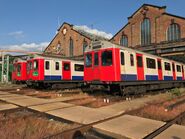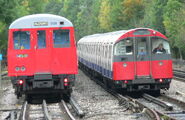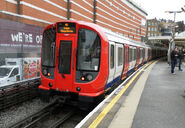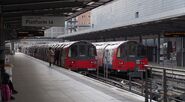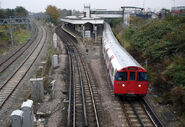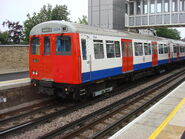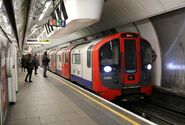Welcome to Rail Transport in London Wiki[]
Rail Transport in London Wiki is an information repository about The London Underground and Overground. The London Underground is one of London's principal icons.
Transport for London (TfL) operated tube lines in London, United Kingdom. The major lines in the London area are Central Line, Circle Line, District Line, Jubilee Line, Northern Line, Piccadilly Line and Victoria Line . Other operators in London are Docklands Light Railway, London Overground, TFL Rail (Crossrail) and Croydon Tramlink.
There are also several lines outside London that run services either wholly or partly within the area. These services connect London with parts of Buckinghamshire, Essex and Hertfordshire.
Classification of lines[]
The early tube lines in Victorian times, were originally owned by several private companies, were brought together under the "Underground" brand in the early 20th century and eventually merged along with the sub-surface lines and bus services in 1933 to form London Transport under the control of the London Passenger Transport Board (LPTB). The current operator, London Underground Limited (LUL), is a wholly owned subsidiary of Transport for London (TfL), the statutory corporation responsible for the transport network in Greater London.
As of 2015, 92% of operational expenditure is covered by passenger fares. The Travelcard ticket was introduced in 1983 and Oyster, a contactless ticketing system, in 2003. Contactless card payments were introduced in 2014, the first public transport system in the world to do so.
The system's first tunnels were built just below the surface, using the cut-and-cover method; later, smaller, roughly circular tunnels – which gave rise to its nickname, the Tube – were dug through at a deeper level. The system has 270 stations and 250 miles (400 km) of track. Despite its name, only 45% of the system is actually underground in tunnels, with much of the network in the outer environs of London being on the surface. In addition, the Underground does not cover most southern parts of Greater London, with less than 10% of the stations located south of the River Thames.
Historical classification[]
The idea of an underground railway linking the City of London with some of the railway termini in its urban centre was proposed in the 1830s, and the Metropolitan Railway was granted permission to build such a line in 1854. To prepare construction, a short test tunnel was built in 1855 in Kibblesworth, a small town with geological properties similar to London. This test tunnel was used for two years in the development of the first underground train, and was later, in 1861, filled up.
The world's first underground railway, it opened in January 1863 between Paddington and Farringdon using gas-lit wooden carriages hauled by steam locomotives. It was hailed as a success, carrying 38,000 passengers on the opening day, and borrowing trains from other railways to supplement the service. The Metropolitan District Railway (commonly known as the District Railway) opened in December 1868 from South Kensington to Westminster as part of a plan for an underground "inner circle" connecting London's main-line termini. The Metropolitan and District railways completed the Circle line in 1884, built using the cut and cover method. Both railways expanded, the District building five branches to the west reaching Ealing, Hounslow, Uxbridge, Richmond and Wimbledon and the Metropolitan eventually extended as far as Verney Junction in Buckinghamshire, more than 50 miles (80 km) from Baker Street and the centre of London.
Yerkes soon had control of the District Railway and established the Underground Electric Railways Company of London(UERL) in 1902 to finance and operate three tube lines, the Baker Street and Waterloo Railway (Bakerloo), the Charing Cross, Euston and Hampstead Railway (Hampstead) and the Great Northern, Piccadilly and Brompton Railway, (Piccadilly), which all opened between 1906 and 1907.
The Underground has its origins in the Metropolitan Railway, the world's first underground railway. Opened in 1863, it is now part of the Circle, Hammersmith & City and Metropolitan lines; the first line to operate underground electric traction trains, the City & South London Railway in 1890, is now part of the Northern line. The network has expanded to 11 lines, and in 2016–17 carried 1.379 billion passengers, making it the world's 11th busiest metro system. The 11 lines collectively handle approximately 4.8 million passengers a day.
The LPTB was a prominent patron of art and design, commissioning many new station buildings, posters and public artworks in a modernist style. The schematic Tube map, designed by Harry Beck in 1931, was voted a national design icon in 2006 and now includes other TfL transport systems such as the Docklands Light Railway, London Overground and TfL Rail. Other famous London Underground branding includes the roundel and Johnston typeface, created by Edward Johnston in 1916.
Current Classification[]
| Route | Type of Service | |
| London Underground | Day routes, including 24-hour services. | |
| London Overground | Normally travels through less affluent areas operating only three-four return journeys per hour. Only two routes serve Central London. | |
| TFL Rail | Day routes through East London and Essex. A new route to Heathrow Terminal 4 from Paddington opened in 20 May, another to Abbey Wood will open in December. The service to Reading and full operation will begin in 2019. | |
| Docklands Light Railway | This route uses driverless computered trains, although a human member of staff (called a passenger service agent / PSA) sometimes travels on every train. | |
| Croydon Tramlink | Local day routes, it does not run 24-hours. But a route number similar to London Buses noting the town the tram travels to. | |
| Night Tube | Night routes. |
External Links[]
https://tfl.gov.uk/modes/tube/
https://tfl.gov.uk/maps/track/tube
https://tfl.gov.uk/modes/london-overground/
https://www.visitlondon.com/traveller-information/getting...london/london-tube
Latest activity[]
Photos and videos are a great way to add visuals to your wiki. Add one below!


